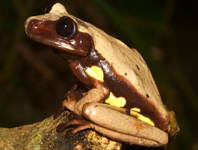Abstract
Nyctimantis rugiceps Boulenger, 1882 (Fig. 1A) is a Neotropical treefrog (Duellman & Trueb 1976; Faivovich et al. 2005) known only from disjunct localities in Amazonian Colombia, Ecuador, and Peru (Pérez-Villota et al. 2009). This species has the skin of the skull co-ossified and reproduces—including calling behavior, egg deposition and tadpole development—in water-filled tree or bamboo cavities (Duellman & Trueb 1976; Duellman 1978). Given its secretive behavior, this is a poorly known species and, as noted by Duellman (1978: 169), “the major clue to the life history of Nyctimantis is the calling behavior of the males”. Unfortunately, the only quantitative description of the advertisement call of N. rugiceps is a brief passage in Duellman (1978) based on four specimens from Santa Cecilia, Ecuador, where important variables are missing (e.g., call duration). More importantly, graphs illustrating the waveform and spectrogram are missing. Considering these limitations and the importance of advertisement calls to the study of anurans (Köhler et al. 2017), we provide a quantitative description using a call recording obtained in Leticia, Amazonas, Colombia.
References
Bioacustics Research Program (2013) Raven Pro: Interactive Sound Analysis Program. Version 1.5. The Cornell Lab of Ornithology, Ithaca, NY. Available from: http://www.birds.cornell.edu/raven (accessed 30 October 2018)
Boulenger, G.A. (1882) Catalogue of the Batrachia Salientia s. Ecaudata in the Collection of the British Museum. Second Edition. Taylor and Francis, London, 563 pp.
Cocroft, R.B. & Ryan, M.J. (1995) Patterns of advertisement call evolution in toads and chorus frogs. Animal Behaviour, 49, 283–303.
Duellman, W.E. (1978) The biology of an Equatorial herpetofauna in Amazonian Ecuador. The University of Kansas Museum of Natural History Miscellaneous Publications, 65, 1–352.
Duellman, W.E. & Trueb, L. (1994) Biology of Amphibians. Baltimore (MD): Johns Hopkins University Press, Baltimore, 670 pp.
Duellman, W.E. & Trueb, L. (1976) The systematic status and relationships of the hylid frog Nyctimantis rugiceps Boulenger. Occasional papers of the Museum of Natural History, The University of Kansas Lawrence, Kansas, 58, 1–14.
Faivovich, J., Haddad, C.F.B., Garcia, P.C.A., Frost, D.R., Campbell J.A. & Wheeler, W.C. (2005) Systematic review of the frog family Hylidae, with special reference to Hylinae: phylogenetic analysis and taxonomic revision. Bulletin American Museum of Natural History, 294, 1–240.
Köhler, J., Jansen, M., Rodríguez, A., Kok, P.J.R., Toledo, L.F., Emmrich, M., Glaw, F., Haddad, C.F.B., Rödel, M.-O. & Vences, M. (2017) The use of bioacoustics in anuran taxonomy: theory, terminology, methods and recommendations for best practice. Zootaxa, 4251 (1), 1–124.
http://dx.doi.org/10.11646/zootaxa.4251.1.1Pérez-Villota, J.E., Anganoy-Criollo, M.A. & Betancourth-Cundar, M. (2009) Amphibia, Anura, Hylidae, Nyctimantis rugiceps: Distribution extension, Colombia. Check List, 5, 270–272.
R Development Core Team (2012) R: A language and environment for statistical computing, Version 2.15.1. Available from: http:// www.R-project.org (accessed 19 November 2013)
Sueur, J., Aubin, T. & Simonis, C. (2008) Seewave, a free modular tool for sound analysis and synthesis. Bioacoustics, 18, 213–226.

